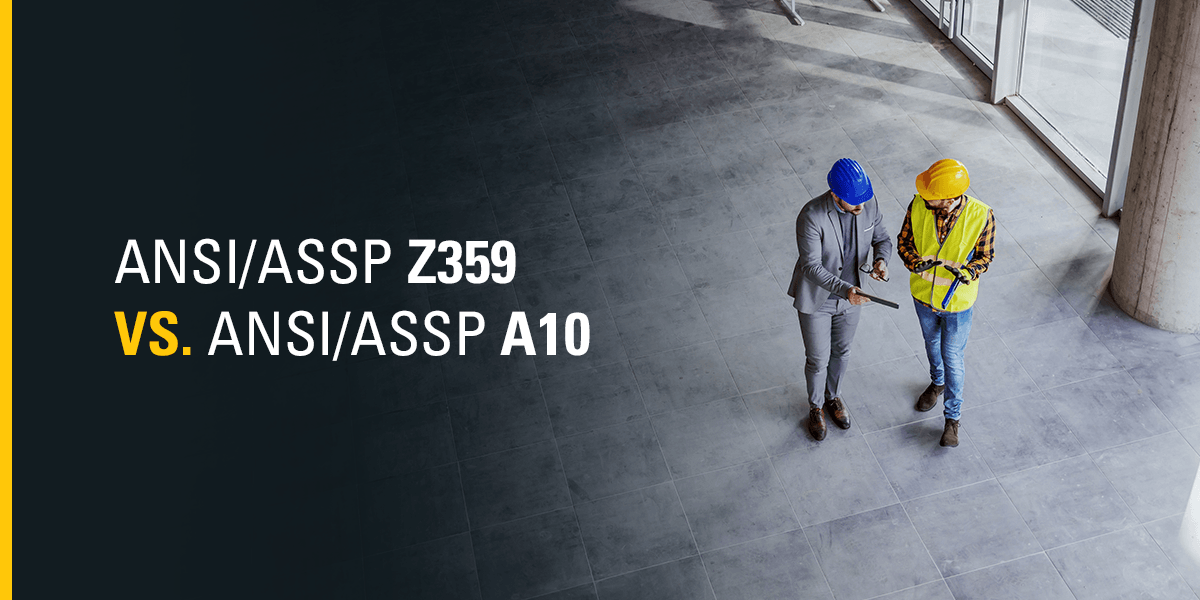
ANSI/ASSP Z359 Versus ANSI/ASSP A10
March 17, 2022
The American National Standards Institute (ANSI) is a non-profit organization that oversees creating, standardizing, and implementing thousands of regulations and guidelines that impact businesses in almost every industry. ANSI also ensures that the organizations involved in creating the regulations and guidelines are legitimate experts in their respective fields through a process they call accreditation.
Similarly, the American Society of Safety Professionals (ASSP) develops workplace safety standards that go beyond OSHA’s. ASSP is also the secretariat for multiple standards committees, which means they supervise the development of standards according to ANSI procedures. The ANSI/ASSP tag at the beginning of the standard indicates that the standard has undergone this process.
Although these accredited standards are not law, they are nationally accepted as safety standards that every organization should follow. Two important standards in the fall protection industry are ANSI/ASSP Z359 and ANSI/ASSP A10.
ANSI/ASSP Z359
ANSI/ASSP Z359 was originally a safety standard for general and non-construction industries. Originally published in 1992 and later revised in 1999, this standard was intended to be the first part in a series addressing comprehensive fall protection programs. This standard initially addressed only fall arrest systems and equipment. In 2007, ANSI released the ANSI/ASSP Z359 Fall Protection Code as the umbrella for a series of 17 fall protection standards.
These 17 standards address not just fall arrest systems and equipment, but all fall protection systems and equipment for general industry. To date, the ANSI/ASSP Z359 committee has released 10 of the 17 sections.

ANSI/ASSP A10
The ANSI/ASSP A10 standards apply to the demolition and construction industries. The construction industry standards cover important requirements for steel erection, scaffolding, fall protection, and safety nets. The demolition operating standards cover hoists for rope-guided and non-guided workers, debris net systems, commercial explosive and blasting agents, rigging qualifications, digger derricks, and hearing loss prevention.
Falls and other disasters can happen from high work platforms in either situation, but demolition comes with extra risk. OSHA describes demolition as construction in reverse, but with extra hazards resulting from unknown factors. For example, buildings can have toxic materials like lead and asbestos hidden within their structural framework, or a building could have undergone modifications that changed the original design. Either way, a demolition manager needs to be on extra-high alert to protect their team from injury.
ANSI/ASSP A10.32 is the standard for fall protection systems in construction and demolition operations. To date, the ANSI/ASSP A10 committee has released 37 standards in ANSI/ASSP A10 and has 9 standards that have been proposed but not completed.
Which Standard Is Right for Your Business?
So should your business follow ANSI/ASSP Z359 (general industry) or ANSI/ASSP A10 (construction and demolition industries)? The short answer is: refer to ANSI/ASSP Z359 for fall protection. Unlike OSHA, the existing ANSI standards do not define what constitutes construction or general industry. Although OSHA does define the construction industry and general industry, it is not always clear which one is applicable. Some businesses may even fall under different industry designations in different situations. For this reason, it is typically best to default to the standards of ANSI/ASSP Z359 to ensure both worker safety and standards compliance.
Additionally, the ANSI/ASSP Z359 committee has proposed measures to make ANSI/ASSP Z359 applicable to all industries. If this transition were to take place, ANSI/ASSP A10 fall protection requirements would compliment or reference ANSI/ASSP Z359. As it stands now, ANSI/ASSP Z359.2 should be considered the most important fall protection standard to follow for any industry because it “establishes guidelines and requirements for an employer’s managed fall protection program.” ANSI/ASSP Z359.2 explicitly states, “This standard is for use by organizations where employees are exposed to fall hazards.” If you are unsure of which standard to follow, ANSI/ASSP Z359 is probably your best bet.

Learn More About Our Fall Protection Systems
At Rigid Lifelines, we strive to create work zone safety solutions that work. We have more than two decades of experience in designing rigid rail fall protection systems, so you can trust us to provide a practical solution for your operation.
Contact a Rigid Lifelines representative today to find out which of our products are most suitable for your operation.
Categories
Share this post
Let us help you
Contact us today to find the perfect product fit for your job
